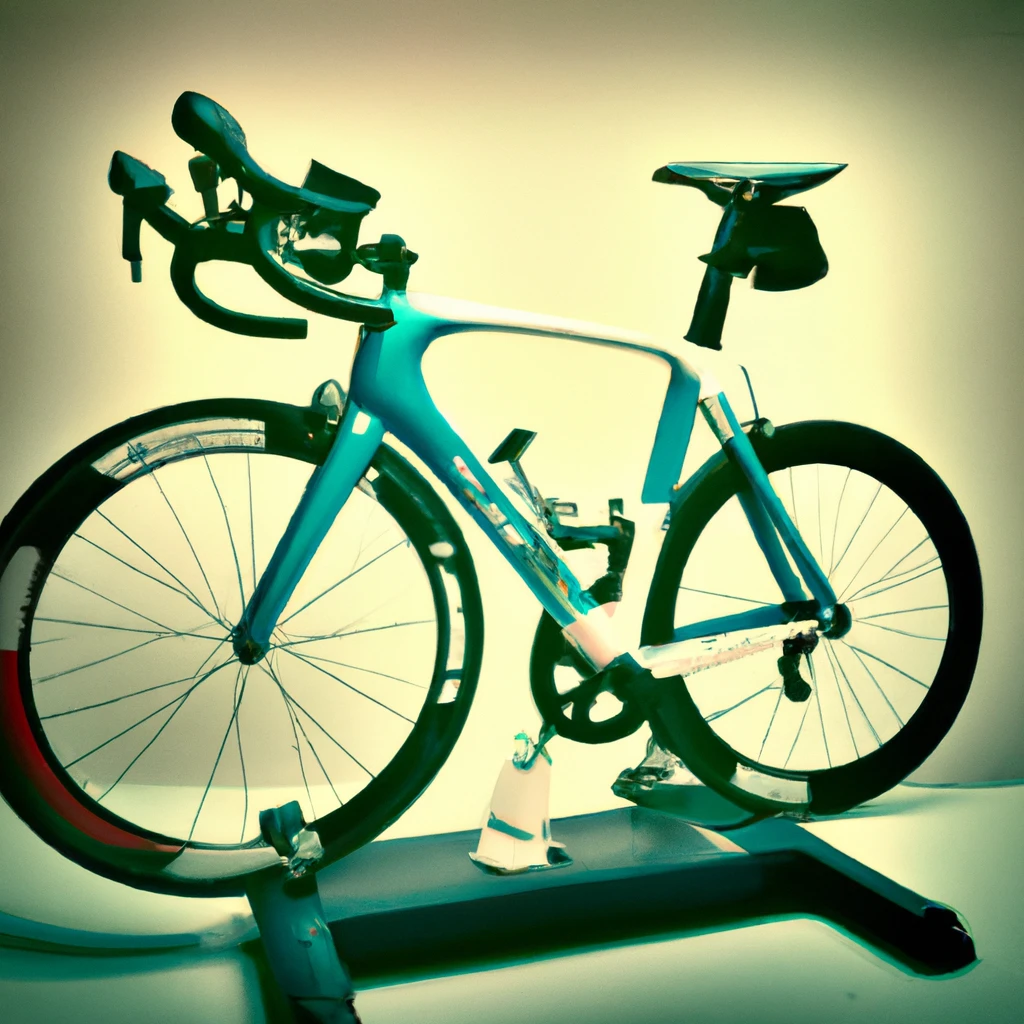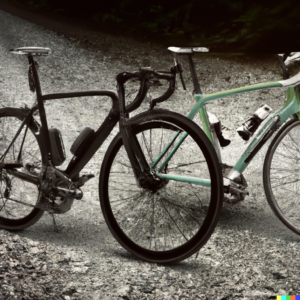Introduction: My Journey with Smart Turbo Trainers
Having always been an avid cyclist, my initial reaction to indoor training was, if I’m being honest, less than enthusiastic. I mean, why would I want to pedal away in my living room when I could be out on the open road feeling the wind in my hair, right? But then, I came across the concept of a smart turbo trainer, and it was a revelation. This wasn’t just about getting out of the rain; it was about transforming the way I approached cycling altogether.
My first encounter with a smart turbo trainer was an unexpected surprise. During a visit to a fitness technology expo, I chanced upon a demonstration booth displaying these high-tech pieces of cycling equipment. At a glance, they struck me as high-tech torture devices, but the enthusiastic representative encouraged me to try one out.
And boy, was I blown away.
I was transported from a crowded expo floor to the steep inclines of the Swiss Alps in a heartbeat, all the while pedaling furiously in place. The rich digital interface, the automatic resistance changes, the real-life simulation, it was as if I was really there, tackling the intimidating peaks. Hooked, I immediately knew that I needed to delve deeper into the world of smart turbo trainers.
My journey, since that day, has been a mix of research, comparisons, trials, and yes, a few missteps (including a not-so-smart trainer that was less turbo and more turtle). But every step brought me closer to understanding what goes into picking the perfect smart turbo trainer. And because I don’t want you to make the same mistakes I did, I’ve put together this comprehensive buyer’s guide to walk you through what you really need to look for when buying a smart turbo trainer.
What follows is a deep dive into my experiences, my expert examinations, and a healthy dollop of advice from one keen cyclist to another.
What is a Smart Turbo Trainer and Why Do Cyclists Need One?
My encounters with smart turbo trainers were life-changing, and trust me, I don’t say that lightly. Once, I was helplessly tethered to the cycling schedule dictated by the whims of weather and, let’s be honest, some unavoidable social commitments. However, the day a smart turbo trainer rolled into my life (quite literally), it triggered a complete paradigm shift. With it, a new realm of freedom in cycling training glistened with possibilities. Having experienced this transformation firsthand, I feel obligated to articulate why every serious cycler can benefit from this incredible innovation. So, let’s delve into what a smart turbo trainer is and why I genuinely believe every cyclist needs one.
A smart turbo trainer, in simplest terms, is a static cycling device that propels your indoor cycling endeavors to new heights of performance. It’s like transforming your bike into a stationary yet power-packed trainer. As the name suggests, it’s “smart,” equipped with advanced tech that offers a cornucopia of features like swift integration with your devices, tracking and analyzing your performance metrics, and providing a simulated environment for a more immersive riding experience. Suddenly, the “smart” moniker makes a lot of sense, doesn’t it?
But, why do cyclists need one, you ask? Let me quell any doubts with my tried-and-true reasons.
- Weatherproof Training: Be it rain, snow, or the scorching summer sun, a smart turbo trainer shields you from external weather conditions that can impact your training schedule. It offers the freedom to cycle whenever and however long you choose. After all, climate control is a luxury in the unpredictable world of outdoors, isn’t it?
- Safety: With a smart turbo trainer, dangers of traffic, treacherous terrains and poor visibility become non-issues. Ride to your heart’s content without a worry in the world.
- Data-driven Training: With precise data on speed, distance, heart rate, and power output, you’ve an upper hand in tracking your progress and tailoring your workouts effectively. Who thought numbers could be so exciting?
- Social Interaction: You might think, an indoor trainer sounds awfully lonely. Well, thanks to the integration capabilities with popular cycling platforms, you can race with virtual riders, join group workouts and engage in virtual cycling communities across the globe. A sense of community, even in isolation, dear cyclist, that’s what a smart turbo trainer offers you.
- Truly Dynamic Resistance: Unlike traditional indoor trainers, smart turbo trainers can replicate the feeling of riding up and down hills by adjusting resistance based on the virtual terrain. Who says you can’t climb Alpe d’Huez while enjoying a cup of joe in your living room?
That, folks, is why a smart turbo trainer is a brainstorm of genius that fills in the gaps of traditional cycling, especially when it’s impractical to venture outdoors. After my adoption of the smart turbo trainer, I’ve never looked back, and it’s a bet I’m willing to make: once you try it, you won’t either.
The Benefits of Using a Smart Turbo Trainer
Let’s take a deep dive into why smart turbo trainers are a game-changer for the cycling world. There are numerous benefits to incorporating a turbo trainer into your cycling routine, and I will share some based on my personal experience and as recognized by community consensus.
- Flexibility and Convenience: There’s no denying that one of the key benefits is the absolute convenience it brings to your training. Bad weather? Limited daylight? No problem! With a smart turbo trainer, you can cycle anytime and anywhere without leaving your home. This also means you can easily fit your cycling routine around your schedule.
- Data Accuracy: The precision and variety of data provided by these devices are unparalleled. They accurately measure power, speed, cadence, and heart rate, which are extremely useful for analyzing your performance and planning your training. Plus, you can easily track your progress over time.
- Interactive Training Sessions: With a smart turbo trainer, gone are the days of monotonous indoor cycling. Many models can integrate with popular cycling apps like Zwift and TrainerRoad, which turn your exercises into interactive, simulated outdoor rides or structured workouts. Trust me, it keeps things engaging and fun!
- Structured Training Plans: If you’re serious about getting better, a turbo trainer is your best friend. They’re designed to integrate with training software offering a wide range of pre-loaded workouts and training plans based on your fitness level and goals. It takes the guesswork out of your training, ensuring you’re always training at the right intensity.
Who wouldn’t want to enhance their training sessions with these features? But before you jump into getting your own smart turbo trainer, there are crucial factors to consider. Let’s delve into them next.
Choosing the Right Smart Turbo Trainer for Your Needs
Having been a passionate cyclist for many years, I’ve tested and used an array of smart turbo trainers. They are not all designed equal, my friend. It’s key to determine what exactly you’re looking for and understand that the right smart turbo trainer for your needs largely depends on your individual cycling goals. Do you want to push your training to the limits or simply conquer mountain passes in your living room?
In your quest to find the best smart turbo trainer, remember to factor in your budget and the amount of space you have available. Professional-grade smart turbo trainers come with a hefty price tag but offer superior features such as precise power accuracy, while on the other hand, compact and more affordable options may meet your needs just as well without breaking the bank.
Set Your Priorities and Goals
Directive, Motivation, Mastery – that’s how I abbreviated my targets when I started using these machines. Now, let’s flesh this out, shall we?
- Directive: What is your specific purpose for getting a smart turbo trainer? High-intensity training, endurance development, or immersive indoor cycling experience? You need to decide your direction.
- Motivation: Ensure that your machine will help you remain focused on your cycling schedule. For example, having a variety of virtual courses can keep you motivated.
- Mastery: Choose a turbo trainer that can help you master your skills, like enhancing cycling speed or climbing steep hills.
Picking Based on the Type of Smart Turbo Trainer
Smart turbo trainers largely come in three types – tire drive, direct drive, and rollers. Let’s not go down the rabbit hole of detailing these, I’ve already covered them in a separate section. However, it’s essential you choose according to your preferred riding style. For example, if you’d like the feel of a real road, tire drive or roller might be the best choice. Yet, for absolute stability and precision, a direct drive might be your match.
Your Budget – How Much Should You Spend?
Price is what you pay. Value is what you get. – Warren Buffett
With several price ranges available in the market, it’s tempting to splurge on advanced models with every possibly-needed high-end feature. But I reckon, as someone who has journeyed through the cycling world, it’s more important to find a model that truly matches your needs. Spend wisely, my friend.
In conclusion, finding the right smart turbo trainer is a journey in itself, one that requires careful consideration. Remember, this training investment is one you’ll be spending significant time with, so it’s worth the effort to pick the perfect fit!
Considerations Before Buying a Smart Turbo Trainer
Once you have a rough idea of what you’re looking for in a smart turbo trainer, it’s time to delve into some of the more detailed considerations before making your investment. Remember, choosing wisely now can save you money and frustrations down the line.
Think About Your Training Space
The first thing you need to consider is the space where you’ll be training. You want it to be a place where you can focus, where your cycling performance will not disturb others, and where you’ll want to spend a substantial amount of time. Ask yourself:
- Is the room well-ventilated?
- Do you have enough space for the trainer and bike?
- Can the floor handle the weight and vibrations?
Remember, a smart turbo trainer isn’t a small piece of equipment. Make sure you have enough room to set up and store it comfortably.
Assess Your Technical Needs & Capabilities
Next, you should turn your attention to the technical requirements of a smart turbo trainer. There’s no use in investing in a high-tech piece of equipment if you can’t make the most of its capabilities. Take into account:
- Your home Wi-Fi speed: Some trainers require a stable, fast connection for the best performance. If your Wi-Fi isn’t up to scratch, it’s worth considering an upgrade.
- Your gadget compatibility: Make sure that the trainer you choose is compatible with the devices you intend to use (be it a smartphone, tablet, or laptop).
- Power source: Does the trainer need to be plugged in, or does it have a self-powering option?
Long-Term Durability
Finally, let’s talk about durability. This is a crucial consideration, especially if you’re planning on doing high-intensity workouts.
From personal experience, I can’t stress enough how important this aspect is. One of my earliest turbo trainers broke down within months – a disappointing experience that delayed my training progress significantly. From that point, I pledged to always opt for trainers known for their durability and longevity. Some tips to ensure you’re buying a durable trainer:
- Read customer reviews: They can provide insight into a product’s lasting power.
- Consider renowned brands: They often have rigorous testing procedures that lesser-known brands don’t.
- Look out for warranty: It shows the company stands by the durability of its product.
By the end of this stage, you should have a good understanding of the key elements you need in a smart turbo trainer. If you follow these consideration points, you’re bound to find a trainer that is tailor-fit for your needs and goals.
Understanding Resistance Levels and Power Accuracy
Resistance levels and power accuracy are two of the most important factors I consider when choosing a smart turbo trainer. Why? Let me explain how these two elements play a crucial role in one’s training program. It’s akin to cake- without the right amount of ingredients, you’ll fall short of the desired result.
Resistance Levels:
Imagine sprinting on a flat road. Now, imagine doing the same on an inclined plane- say, a steep hill. Which one do you think will make you pant harder? Right, we’re on the same page. It’s the latter: the resistance provided by the incline makes your muscles work harder. Similarly, the resistance in a smart turbo trainer essentially determines how ‘hard’ it feels to pedal. Higher resistance levels simulate uphill climbs, and lower levels replicate flat or downhill courses.
Modern smart turbo trainers often provide detailed control over the resistance. These trainers usually have a wide range of settings, allowing you to dial in the exact level of intensity you want for a workout. My personal experience has taught me the greater the number of resistance levels a trainer offers, the more flexible and versatile it is, catering well to different workouts and fitness goals.
Power Accuracy:
Power accuracy, on the other hand, is essentially how believable those numbers flashing brightly on your trainer’s display are! And trust me, having accurate data to rely on is both a motivator and a powerful tool for tracking performance progress.
Each smart trainer will have a certain degree of power measurement tolerance typically expressed as a percentage like ±2%. The smaller the percentage, the better, as it provides more accurate data. Power accuracy is vitally important because it forms the basis of your performance metrics. It shapes your virtual racing, structured workouts, and training plan adaptations, thereby directing your progress as a cyclist.
Time and again, I’ve realized through my own training, using a turbo trainer with a high degree of power accuracy, despite its relatively greater cost, yields dividends in terms of performance improvements and consistency over time. You’ve probably heard the phrase ‘Trust the process’. In cycling training, it’s essential to add to that – ‘Trust the accurate data’!
I believe grasping the importance and implications of resistance levels and power accuracy in smart turbo trainers empowers us to make informed purchase decisions. Moreover, it ensures a fulfilling and productive training experience.
Key Concept Recap
- Resistance levels dictate how hard or easy it is to pedal on the trainer – simulating different road conditions and cycling intensities. The more levels, the better.
- Power accuracy is all about how accurately the smart trainer measures your efforts. A lower tolerance percentage reveals a higher degree of power accuracy.
Next up, let’s delve deeper into the various types of smart turbo trainers available in the market and which one might be the best fit for you.
Exploring the Different Types of Smart Turbo Trainers
As a seasoned cyclist, I can tell you, the diversity in smart turbo trainers can overwhelm even the most well-informed enthusiast. Let me alleviate some of that uncertainty by presenting you with a detailed exploration. These smart devices come in all different configurations and functionalities. Allow me to break down the most common ones for you.
The Wheel-On Smart Turbo Trainers
Wheel-On trainers, like the sounds of it, involve your bike’s back wheel. The tire of your wheel bears against a resistance unit, and you’re all set to ride. Wheel-On smart trainers are usually more affordable but slightly less accurate when it comes to measuring power. They’re a favorite amongst newbies and intermediates looking to dip their toes into indoor cycling.
The Direct Drive Smart Turbo Trainers
Ever wondered what the gold standard of smart turbo trainers looks like? Presenting the Direct Drive Trainers, where you remove your bike’s rear wheel and mount it directly onto the trainer. With an inbuilt gear cassette, these trainers provide a low-noise and realistic ride feel, coupled with precise power accuracy. I’d recommend them to anyone who takes indoor cycling seriously. Just remember to check compatibility with your bike beforehand!
Smart Rollers
Want to add more ‘adventure’ to your indoor escapades? Try the Smart Roller trainers! These devices help you ride freely atop three spinning cylinders, thereby offering a unique experience. The catch? Well, they are harder to master and balance on. These trainers are the best for folks looking to improve their pedaling technique and balance skills while getting a good cardio workout. But be prepared to face a steep initial learning curve.
There’s a smart turbo trainer for every personal preference and goal – but remember, your decision should be dictated by what suits your cycling style, fitness objectives, expense limits, and technical comfort rather than popularity or aesthetics. And of course, don’t hesitate to experiment a bit!
Flywheel Smart Trainers
For the serious cyclist, the Flywheel trainers are hard to ignore. They’re defined by a mechanical flywheel designed to replicate the inertia experienced while cycling outdoors. Typically found in direct drive trainers, heavy flywheels contribute to a smoother ride and greater resistance. Go for it if ‘authenticity’ ranks high on your requirement list!
To sum up, each turbo trainer type has its own unique advantages – wheel-on trainers for affordability, direct-drive trainers for accuracy and feel, smart rollers for balance training, and flywheel trainers for realism. So, what type of Smart Turbo Trainer will fit your trainer room best? Remember, finding the right one is a journey, not a race. Happy pedaling!
Key Features to Look for in a Smart Turbo Trainer
If I’ve learned anything from my years of cycling and experimenting with different smart turbo trainers, it’s that the devil is in the details. These are not just standard pieces of fitness equipment – they are a vital part of your training arsenal, and as such, they must possess quality features that will enhance, not hold back, your progress. Let’s delve into what exactly you should be looking out for when you’re in the market for a new smart turbo trainer.
Noise Level
The very nature of turbo trainers means they can generate a lot of noise, especially at higher resistance levels. If you’re living in a flat or training late at night, this could pose an issue. Many smart turbo trainers on the market today are nicely optimized to keep the noise levels down. Brands like Elite and Tacx are particularly renowned for their quiet machines. I’ve had experience with both, and can vouch for their hushed operation.
Max Power Output
Max power output refers to the maximum amount of power the trainer can handle. It’s a crucial feature for more advanced cyclists looking to push their limits. Some trainers can go up to 2,500 watts, but do you really need that much? Remember my previous point on setting goals and priorities. It all comes down to the requirements of your training routine.
Ride Feel
One of the game-changing aspects of the smart turbo trainers is their ability to simulate real-world riding conditions. Brands have gone to great lengths to recreate the sensation of cycling outdoors. The best simulators will make you feel like you’re really on the road, needling up a gradient or hammering down a descent. As someone who’s spent a lot of time cycling outdoors, this feature was a major factor in my decision-making process.
Device Compatibility
Not all smart turbo trainers are compatible with all devices. This can be a pitfall for many new users. Before making your purchase, make sure to confirm that your turbo trainer will work with your existing devices. This includes verifying whether it will pair with your PC, smartphone, or tablet and connect with your preferred third-party apps like Zwift or TrainerRoad.
Stability and Build Quality
When you’re in the crux of a hard training session, trust, you don’t want to be worrying about your turbo trainer toppling over. Invest in a trainer with a stable, robust design. If you want an idea of which trainers pass the test, Wahoo and Elite offer particularly reliable units.
Each of these elements will play a part in your overall training experience and could make the difference between a good trainer and a great one. Taking time to research and assess your priorities, and then matching those up with the features you find most important, is the smartest approach to finding the ideal turbo trainer.
Compatibility with Popular Cycling Apps and Platforms
When it comes to the integration of smart turbo trainers to your cycling ecosystem, compatibility with popular cycling apps and platforms is a crucial consideration. It’s not just about the hardware specs, but about the seamless software experience that can take your indoor training to a whole new level.
Imagine this: you are pedalling away on your trainer, your sweat forming puddles around you, your heart pounding like a drum in your chest, but you aren’t just mindlessly staring at a wall or a TV screen. Instead, you’re scaling a virtual alp, racing against cyclists from around the globe, or following along a structured workout with visual prompts, all through platforms like Zwift or TrainerRoad.
Here, I’ll delve into a few points that you should look for while considering the compatibility aspect:
- Zwift Compatibility: Zwift is arguably one of the most engaging virtual training platforms that can transform your indoor training experience with simulated environments, structured workouts, and social aspects. Therefore, look for trainers that can easily connect with Zwift. It’s a bonus if your trainer can depict the virtual gradients, providing you with a near-real experience.
- TrainerRoad Compatibility: For structured training, few platforms rival TrainerRoad. It provides personalized training plans tailored to your fitness level and goals. Opt for a smart turbo trainer that can sync seamlessly with TrainerRoad.
- Bluetooth and ANT+: These are the two common wireless protocols used by smart turbo trainers to connect to your devices and transmit data. Ensure your smart trainer supports the same wireless standard/s as that of your device/s (Smartphone, tablet, heart rate monitor, power meter). ANT+ supports multiple device connection, while Bluetooth supports higher data speeds.
- Rouvy and Sufferfest: These are other popular immersive platforms with augmented reality routes and race environments. Check if your trainer is compatible with these platforms as well.
Remember, while you would generally have the option to use third-party apps to bridge the hardware-software gap; a seamless, native compatibility is always a more hassle-free approach. After all, who wants to grapple with tech issues when all you want to do is hop on your bike and ride?
Choosing a Smart Turbo Trainer with Great App Compatibility
The above points underscore some of the main connectivity considerations, but of course, there’s a bit more to this digital facet of trainers. The nature of OS (Operating System) support and firmware updates, for instance, can impact the user experience over time. A smart turbo trainer doesn’t just stop being ‘smart’ the moment you unpack and install it, right?
Some trainers also offer proprietary software with features like data analysis, customizable training plans, and even virtual coaching. Knowing what you need and matching those needs with what’s available, is the key to a wise purchase decision.





